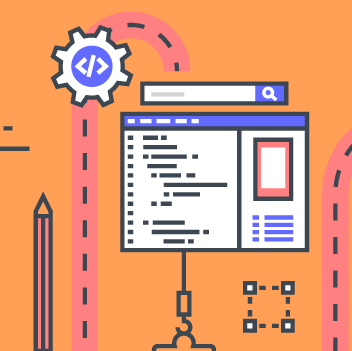
How to eliminate pain points of software design and architecture
Lucid Content
Reading time: about 10 min
The process of software development can go smoothly or be fraught with problems. Often, the difference between these outcomes boils down to the planning you do. With the right approach, you can reduce the risk of your project running over budget and out of scope.
Use these best practices to stay on track.
The software architecture development process
Before your engineering team can start developing software, you need a software architecture design. Your software architecture provides a blueprint that organizes and helps you conceptualize a system. This includes your software’s operational environment, which components your software should include, and any structural elements and constraints that should be considered.
Without a clearly defined software architecture process, your team runs the risk of having too much uncertainty and complexity during the development phase. This can introduce unintended problems for your engineering team.
Most common pain points in software development
Software projects often suffer from these pain points, but yours doesn’t have to. We’ve included tips and best practices to help you manage these issues before they become overwhelming problems.
Unrealistic expectations
No software project can be absolutely perfect in the real world, but every project manager and engineer wants the best possible outcome. Sometimes, however, striving for perfection in one requirement or feature means sacrificing the quality of others. Project resources are finite and different design features may conflict with one another. Stakeholders and project team members may hold unrealistic expectations of what the final product can accomplish.
Inaccurate expectations don’t just come into play with project requirements, either. Your team might be expected to turn around features and milestones too quickly. Issues and challenges that come up might not be appropriately planned for, leaving your stakeholders surprised when something goes wrong.
These differences in expectations could arise from skipping part of the project planning process. Before it all goes wrong, you need to brainstorm about what obstacles might show themselves during development.
-
Brainstorm potential problems: As you plan your project, consider doing a SWOT (strengths, weaknesses, opportunities, threats) analysis. Some teams note the strengths and opportunities but forget to look closely at the weaknesses and threats. You may think of weaknesses as internal obstacles or challenges and threats as external factors that can hinder your project’s success.
-
Sketch out solutions in advance: Choose issues you’ve identified and start documenting potential solutions to help your team manage, reduce, eliminate, or avoid risks. Although you can’t always identify every possible risk and solution in advance, doing your homework will help you prepare and stay ahead of potential challenges.

Start off on the right foot by recording functional requirements and other essential information in a software design document.
Learn howIntegration issues
Compatibility problems can derail a software project. If the final system doesn’t pair successfully with existing tools that your users rely on, then your overall project could be less useful or you might find yourself backtracking significantly.
Make sure integration issues don’t get in your way by using an API (application programming interface) or connecting with other technologies and forming strategic partnerships.
-
Leverage APIs: With APIs that streamline the interaction between your system and your users’ other applications, you can maintain your engineering team’s focus on other issues such as the user interface and the app’s functionality.
-
Form technology partnerships: Work directly with the developers of other software your users rely on to create integrated software packages that benefit both companies and end-users.
Lack of communication
Project leaders, developers, and designers can all have a different understanding of a project’s requirements. This can greatly complicate the development process and lead to confusion and misunderstandings that may derail the project or delay key milestones. For example, if the team doesn’t completely understand the vision presented by the project champion, implementation of that vision might result in a finished product that doesn’t meet the brief.
To prevent a lack of communication from destroying the project, you should develop a communications plan and set expectations early on.
-
Avoid assumptions: Communication errors are often caused by unfounded assumptions. The best way to reduce assumptions is by continuing to ask questions.
-
Bring in users: Your users and core stakeholders should be able to provide feedback and help guide the project’s vision and implementation.
Misjudging overall costs
An inaccurate cost estimate at the beginning of the project can lead directly to wasted or misallocated resources. In the end, your project can be over-budget, costing much more than your project leadership planned for. At best, your project is a bit more expensive but is otherwise successful. If your project becomes far too expensive to be practical, however, your organization may need to cancel it or look for features to cut—definitely not a positive outcome.
You can reduce your risk of misjudging overall costs by doing everything you can to determine costs upfront and check in on the numbers during the project as you achieve milestones to see how your spending is matching up with budgets for each area of the project.
-
Be flexible: Know when to be flexible with your budget. A good project plan should assume some budget flexibility, ideally accounting for potential cost increases or changes.
-
Find price ranges: Identify potentially expensive areas of your project early along with a range that includes worst-case scenarios.
Failure to define a target audience
Users and key stakeholders are important throughout the design and development process, but some software projects fail to appropriately define their audiences. Bringing in frequent user input to every part of the development process is part of what sets Agile projects apart. Without a defined target audience, you can wind up creating software for no one in particular or for everyone.
Asking lots of questions, doing what you can to find real users, and involving other parts of your organization can help with this.
-
Talk with users: Have your team sit down with real-life users and learn from their needs, interests, and expectations. This practice can be invaluable to understanding user experience. Using surveys, focus groups, and meetups along with interviews and invitation-only beta testing will provide your team with essential data and anecdotes to shape the target audience further and direct the course of your designs and development.
-
Create a user journey map: Examine your user journey research and plan how your software users will interact with your finished product. A diagram can help you visualize the steps involved from a user perspective.

-
Communicate past silos: Outside of design and engineering, you may find other departments’ input is also essential to defining your audience. The sales and customer support teams, for instance, may already be spending a lot of their time in conversations with the audience you’re creating software for. Get them involved.
Design influences
Any project with many different stakeholders is likely to experience significant pressure. Customers, the outside business environment, and internal factors can all impact the design. Project managers and developers are tasked with managing expectations and keeping different influences in check so that the final outcome incorporates everyone’s influences at the right level and to the correct degree. Too much influence from any one source can adversely impact the overall project.
By focusing your design and creating a consistent experience across different platforms and modes of delivery, you can ensure that the influences you are managing through your project don’t inadvertently interfere with your project’s success.
-
Plan for consistency: Build consistency into your design plans. Be clear upfront about where consistency matters.
-
Manage expectations: Different expectations among team members regarding design can pull the project in different directions, so work hard to keep the team’s expectations on target.
Clarity on deliverables and lack of documentation
Careful documentation and clarity about the project’s final deliverables helps ensure that your project doesn’t end off-scope. By leaving important details undefined, your team is forced to make their own choices, and these decisions may differ from what stakeholders, users, and project leaders had in mind. As the project moves forward and finishes, a lack of documentation can lead to confusion with your developers trying to guess what their teammates intended.
Including quality documentation and specifying the deliverables you need will help you avoid these problems.
-
Create thorough documentation: Your software documentation should not become an afterthought. Include documentation in your development process and make sure it is useful, consistent, standardized, and complete.

Short on time? Learn how to create and manage technical documentation faster.
Read our tips-
Be specific about deliverables: Plan specific deliverables for each sprint and be clear about their requirements, quality, and other scope specifics.
Delays
Generally, software development moves very quickly to keep pace with user expectations and business goals. Unfortunately, delays sometimes happen in software projects. Unexpected, unplanned challenges can occur: you may lose a core team member, or you might encounter communication problems within your team. A delay on one sprint can then push the next sprint back and set your entire schedule off-course.
To avoid delays, it’s important to build extra time into your project plan where you notice potential problems.
-
Encourage communication: Ask your team to voice their concerns about potential delays as early as possible. Some team members may be reluctant to bring up the bad news, but it’s in your team’s best interest to tackle that as soon as possible.
-
Create a buffer: If you know for certain that a particular sprint may be delayed, you can build a buffer into your project plan.
-
Choose experienced teams: Sometimes, delays occur when a software team or project leadership is unfamiliar with a particular type of project. Find experienced team leads to help your team set realistic timelines and plan ahead for delays.
Quality assurance
High-quality software is what every project team wants, but quality doesn’t happen by accident. Quality assurance is a necessary part of making sure your software is successful on launch day. Cutting quality assurance out to meet deadlines usually backfires and leads to more work and more delays.
In other words, you need a formal process for quality assurance and you also need an engineering team that’s committed to it.
-
Create a quality process: Within your project planning phase, talk with your team about quality and how your project’s quality assurance plan will help you review code and find errors early.
-
Encourage your team: Discourage skipping over the testing phase and quality assurance processes. Encourage good quality practices.
Your software project needs conscientious planning and a commitment to following best practices in order to avoid common development pitfalls. Throughout your project, keep up the communication among your team and encourage everyone to follow your processes.
About Lucidchart
Lucidchart, a cloud-based intelligent diagramming application, is a core component of Lucid Software's Visual Collaboration Suite. This intuitive, cloud-based solution empowers teams to collaborate in real-time to build flowcharts, mockups, UML diagrams, customer journey maps, and more. Lucidchart propels teams forward to build the future faster. Lucid is proud to serve top businesses around the world, including customers such as Google, GE, and NBC Universal, and 99% of the Fortune 500. Lucid partners with industry leaders, including Google, Atlassian, and Microsoft. Since its founding, Lucid has received numerous awards for its products, business, and workplace culture. For more information, visit lucidchart.com.
Related articles
What is test-driven development?
Test-driven development can lead to greater efficiency and happier users. Learn all about it in this article.
